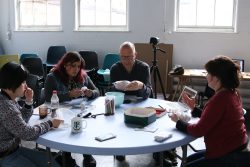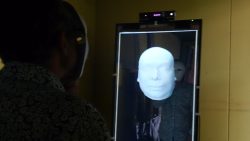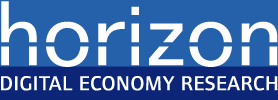30
09
.16
Invisible
Invisible is a Horizon Impact project combining creative approaches to Human Computer Interaction (HCI) research with the development of a new artwork where a mirrored surface becomes an escape from the here and now, creating a doorway to another place and time, a wild fairy tale world, a no-mans land or a bridge across the sea.
The project focuses on interactive mirror technology, previously developed at Horizon/Mixed Reality Lab and adapted to a new artistic context. It is being co-developed by Horizon Research Fellow and professional artist Rachel Jacobs, and British/Brazilian artist and researcher Silvia Leal (Fluminense Federal University, Brazil), and fellow researchers from the Mixed Reality Lab/Horizon – Anthony Brown, Nils Jaeger and Holger Schnadelbach. The project involves three phases: (1) experimentation with the technology; (2) developing an interactive artwork in the UK and Brazil; (3) public engagement activities in the UK and Brazil.
Phase 1 of the Invisible project involved a one week residency at Primary Studios, an artist led studio and public art venue. The Nottingham based team – Rachel Jacobs, Robin Shackford, Holger Schnadelbach and Antony Brown spent a week in the main space at Primary (PS1) experimenting with the mirror technology, developing a simple narrative experience with the mirror that was then displayed in the strange, smelly corridor at the back of the main public space. Rachel Jacobs and Silvia Leal also collaborated via Skype on the broader concepts of the project, the artistic elements and developing narrative interactions.

On the final day of the residency, Primary artist residents and local people were invited to view the experiments and the experimental installation that was created during the week. The aim of the public workshop was to invite local/interested people to contribute to the artistic and technical development of the project and begin conversations about the project themes. Although only four people came along to this first workshop, it provided an opportunity to start a conversation, test how the mirror can trigger conversations and responses to the environment in which it is placed and to work together to write stories and create experience of imaginary spaces.
Phase 2 of the project has involved further developments, with Silvia Leal visiting the UK and co-facilitating a workshop with the UK team and working with Rachel Jacobs to develop further the concept of the interactive mirror, connections between communities in the UK and Brazil. A final brief was agreed around the concept of a suitcase that contained a basic version of the mirror and that could be carried by one of the artists to the location where the project goes live (potentially a remote or environmentally challenging location, such as a forest or a beach). As a result of this work they are exploring issues of impact and abundance, looking at what it means to take part in creative interventions such as these, particularly when there is public funding and university impact agendas involved. How to protect and engage sensitively with the communities that participate and that are visited by the artist. One of the key elements that has arisen from this thinking is Silvia’s notion of ‘abundance’, the nature of the conversations and collaborations that occur, the fragility of the situations, environments and connections but also the abundance of goodwill and engagement that result from these very specific types of creative interventions.

During this second phase some of the participants from the previous workshop were invited back to Primary to take part in a workshop to test the latest Unity interactions designed as part of the mirror technology developments. This included the development of an easy template to add content and interactions and give feedback on the work so far. Seven participants attended this workshop.
The next phase of these developments is to begin building two prototype suitcases (in the UK and Brazil) and begin to build the narrative experience in relation to a specific location in each place, in conversation and collaboration with the communities in each of these places.















